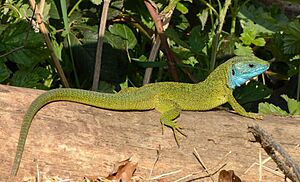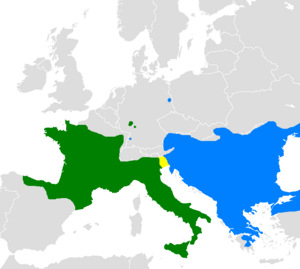European green lizard facts for kids
The European green lizard (also known by its scientific name, Lacerta viridis) is a cool, large lizard found across many parts of Europe. You can spot them from countries like Slovenia and Austria all the way to the Black Sea coasts in Ukraine and Turkey. They love to warm up in the sun on rocks or grassy areas, or hide among bushes.
Quick facts for kids European green lizard |
|
|---|---|
 |
|
| Male | |
 |
|
| Female | |
| Conservation status | |
| Scientific classification | |
| Genus: |
Lacerta
|
| Species: |
viridis
|
 |
|
| Range of L. viridis in blue, and L. bilineata in green | |
| Synonyms | |
|
Seps viridis Laurenti, 1768 |
|
Contents
What Does a European Green Lizard Look Like?
These lizards can grow up to 15 centimeters (about 6 inches) long from their nose to where their tail begins. Their tail can be super long, sometimes twice the length of their body! This means a whole lizard can be up to 40 centimeters (about 16 inches) long. If a predator grabs its tail, the lizard can actually drop it off to escape. Don't worry, a new tail will grow back later!
Spotting the Difference: Males vs. Females
Male green lizards have bigger heads. Their bodies are a bright green with small spots, especially on their backs. Adult males also have a cool bluish throat.
Female lizards are a bit thinner than males. They are often a more solid green color. You might see two to four light stripes on their bodies, usually outlined with black spots.
Where Do European Green Lizards Live?
The European green lizard is native to southeastern Europe. You can find them in many countries, from southern Germany, Austria, and Hungary to Greece, Ukraine, and western Turkey. They have even been introduced to Kansas in the United States!
Their Favorite Homes
These lizards like to live in places with lots of dense bushes and plants. You can often find them in open woodlands, along hedgerows, at the edges of fields, on grassy banks, and in thickets of brambles. They can live in areas up to 2,200 meters (about 7,200 feet) above sea level. In cooler northern areas, they might live on bushy heathland. In warmer southern areas, they prefer damp spots.
How Do European Green Lizards Behave?
European green lizards spend most of their time on the ground or in low, thick plants. They love to bask in the sun, especially in the morning and late afternoon, to warm up.
What Do They Eat?
Their main diet is insects and other small creatures without backbones. But they are not picky eaters! They also munch on fruits, birds' eggs, baby birds, small lizards, and sometimes even tiny mice.
Life Cycle and Reproduction
In the spring, a female lizard will lay between six and twenty eggs. These eggs usually hatch in about two to four months. When they first hatch, the baby lizards are pale brown and only about 3 to 4 centimeters (1 to 1.5 inches) long. They grow quickly and become adults the next year, usually doubling in size!
Who Are Their Predators?
Many animals like to eat European green lizards. These include red foxes, badgers, domestic cats, and various birds. Some birds that hunt them are buzzards, kestrels, and crows. Even some snakes, like adders, will prey on them.
Are European Green Lizards Endangered?
The IUCN (International Union for Conservation of Nature) says that the European green lizard is a species of "Least Concern". This is good news! It means they are found over a wide area and are common in many parts of their range. They are also good at adapting to different environments. Most of the time, there aren't any big threats to their survival. However, in some places like Turkey, pesticides might affect them.


